My ultimate guide for how to make an easy risotto from scratch – in any flavour you like! It really isn’t tricky.
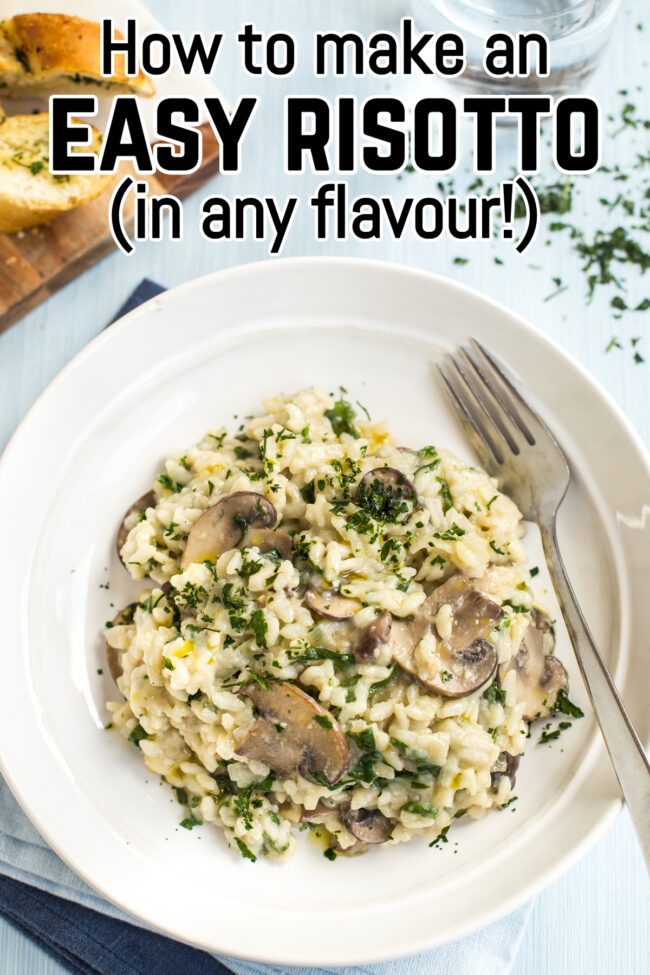
If you’ve ever wondered how to make an easy risotto from scratch, this is the post for you!
And just in case you’re a mushroom hater (I know there are a few of you oddities out there), don’t worry – for the purposes of this post I made a simple mushroom risotto with spinach, since it’s one of my favourites, but I also talk you through how to make your risotto in any other flavour, using any vegetable you fancy. The basic formula is the same for any variety of vegetarian risotto.
So, consider this post your ultimate guide to cooking risotto from scratch!
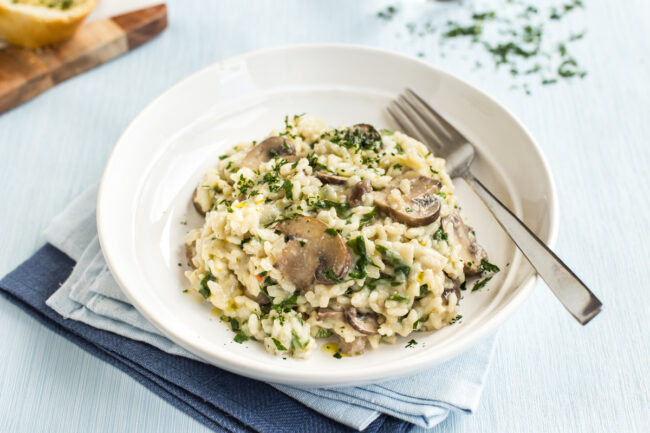
What is risotto?
I’m guessing that if you’re reading this post, you already know what risotto is, but just in case – risotto is an Italian dish that’s essentially a savoury, creamy rice. It’s usually made without any extra cream added – the way the rice is cooked is enough to give that luxurious gooeyness.
Risotto can be made in just about any flavour imaginable – mushroom risotto is a classic, but just about any other vegetable will work too. Carrot risotto, tomato risotto, pea risotto… I mean, I’m not going to literally list every vegetable in the world here, but you get the idea.
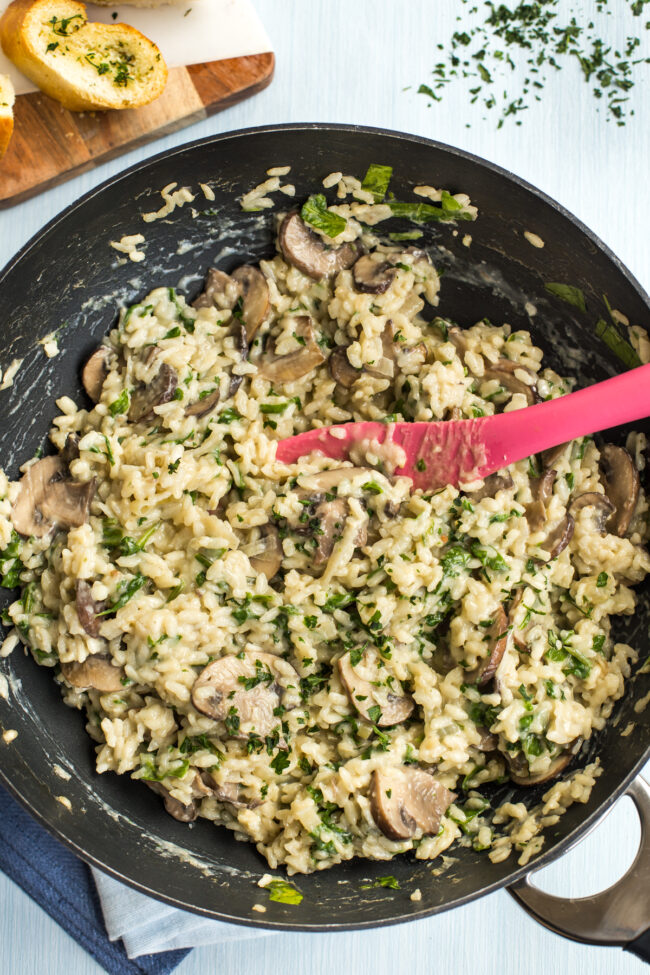
What ingredients do you need to make an easy risotto?
Really, the only ingredient you need to make risotto is rice (although having said that, I have made a cauliflower risotto before…).
But, a risotto made with literally just rice and water would be entirely tasteless, so there are a few other ingredients that you probably want to include.
Here’s my usual ingredients list:
- rice (see below for details!)
- onion / shallots and garlic, to give a tasty base
- some kind of vegetable to flavour the risotto – this time I used mushrooms, but as mentioned, you can use pretty much any veg you like.
- a splash of white wine, sometimes… when I’m not pregnant / when I’m feeling fancy / when there’s some left in the fridge (which isn’t often, I’ll admit)
- vegetable stock – I just use a stock cube dissolved in water, but a liquid stock or jelly stock pot will be great too.
- vegetarian parmesan cheese, to add even more creaminess and richness
- fresh herbs for a pop of flavour
Of course, this is just my own go-to formula – if you have something else that you’d like to include, like a splash of coconut milk, tomato puree, or even a dollop of curry paste, then go for it! If any Italians are reading this, they’re almost certainly wincing at me saying that, but personally I think there should be no rules in cooking – if you can make a tasty meal at the end of it, that should be all that matters.
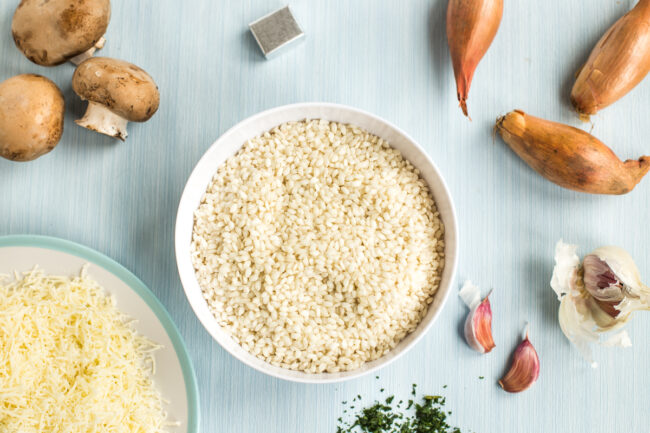
What sort of pan should you use to cook risotto?
To make risotto, you’ll want to use a large pan that’s fairly wide, but still with nice deep sides.
Personally, I always use my wok to make risotto – it may not be a traditional Italian pan, but it’s big enough that there’s plenty of room for stirring! I can’t stand trying to cook in a pan that’s too small for the task at hand.
If you don’t have a wok, just use your biggest, deepest frying pan.
Okay, so you’ve got your ingredients and equipment sorted. Time to start cooking!
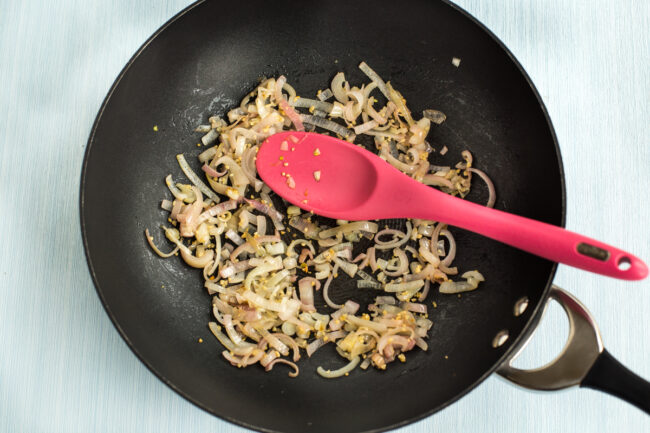
Step 1: Cook your aromatics
By ‘aromatics’, I mean the onion and garlic, or whatever other tasty ingredients you’re using in your risotto. These ingredients won’t be the star of the show, but they’re there to give a base flavour to your food – other aromatics could be ginger, lemongrass, celery, chopped chillies, whole spices, etc.
For my simple mushroom risotto, I just used garlic and shallots (I find they’re a little sweeter and less harsh than regular onions, so they’re nice to use in a special dish).
Your aim is to soften your aromatics and just cook them gently until they become really… well, aromatic. You don’t want them to crisp up or become overly dark in colour, just soft and translucent. They’ll give an amazing flavour to your risotto.
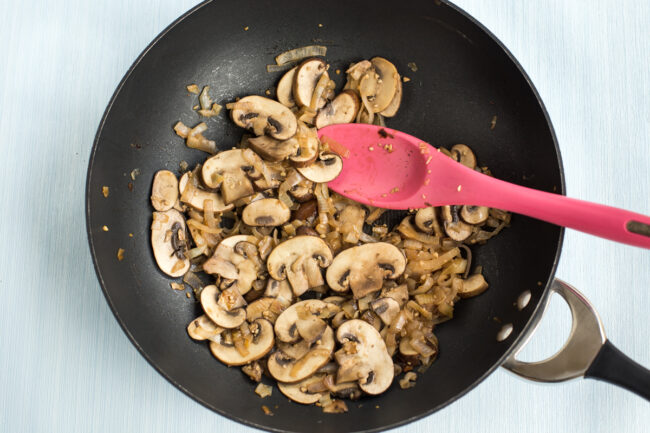
Step 2: Add some of your vegetables to your risotto
This step comes with a bit of a caveat – not all vegetables should be added to a risotto at this stage. If you add broccoli now, for example, by the time your risotto is ready, you’ll end up with overcooked broccoli mush. Softer vegetables that don’t need much cooking can be added later (see step 5!).
Vegetables that you can add at this stage:
- hard vegetables that requires a long cooking time, e.g. carrot or any other root veg
- any vegetable that will be tastier if it’s fried first rather than just boiled with the rice, e.g. mushrooms or peppers
- frozen vegetables like peas or sweetcorn
Just add your veggies to the pan, and cook them for a few minutes.
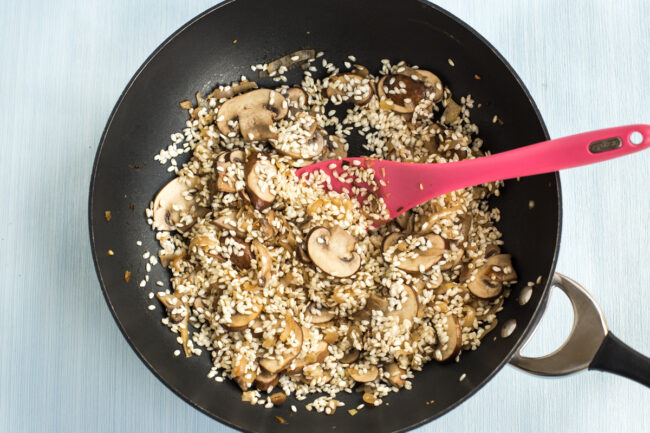
Step 3: Add the rice
Time to add the rice! To begin with, add the dry rice to the pan and give it a good stir to coat it in that tasty, oniony oil. Cook it for just a minute or two – it might start to turn ever so slightly golden, and will take on a slightly nutty flavour as it fries.
What sort of rice should you use to make risotto?
You’ll need to use some sort of short-grain rice for your risotto, as short-grain rices (e.g. arborio) release more starch than long-grain rices (e.g. basmati).
Long-grain rice tends to stay drier and more separate as it cooks, whereas short-grain rice will give a risotto that’s nice and creamy.
In the UK, arborio rice is really easy to find, and carnoroli rice is usually also pretty widely available, so either of those will be great to use in your risotto!
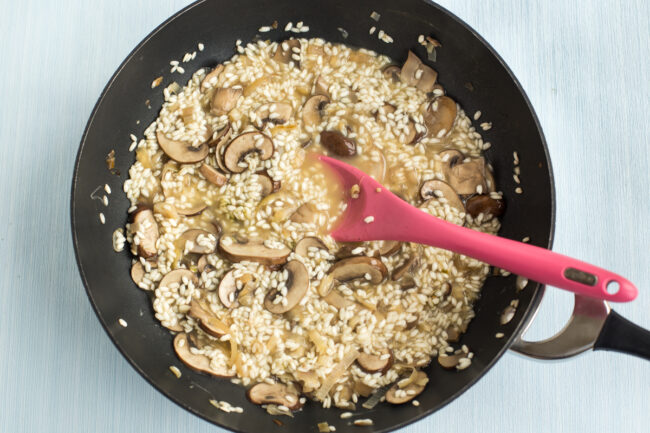
Step 4: Begin adding the liquid
If you like, you can start with a splash of white wine (red wine also works well in some flavours of risotto!). Let it sizzle over a medium heat for a couple of minutes, to cook off the alcohol and give the wine a chance to be absorbed by the rice – it will add a lovely flavour.
Or, you can go straight to adding the veggie stock.
You don’t want to add all the stock in one go – I tend to add about a cup at a time. Allow the stock to be mostly absorbed before you add the next bit. You don’t ever want the rice to get completely dry, you just don’t want there to be loads of excess liquid in the bottom of the pan. Let it soak into the rice, then add another cupful.
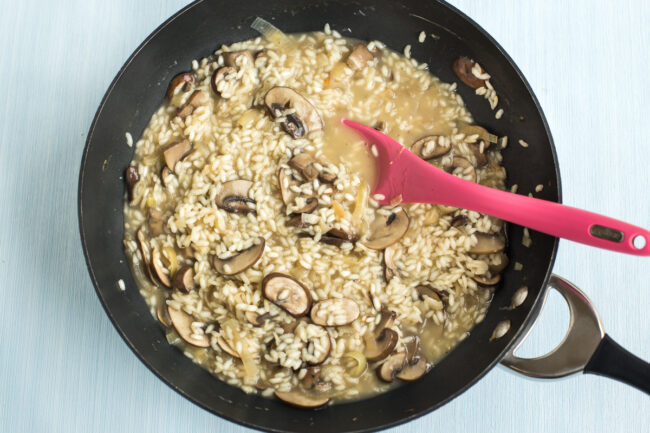
Top risotto tip: Use an electric kettle for your stock!
Some recipes recommend keeping a separate saucepan of vegetable stock simmering on the stove, so you can ladle it into your risotto a bit at a time. Personally, I find this a bit of a faff – who wants an extra pan to wash? Plus I always end up dripping it all over the stovetop.
My method is that I crumble the stock cube straight into the rice, then just add hot water from the kettle. You can reboil it at any time if it starts to cool off, and just pour in as much as you like each time. So much easier.
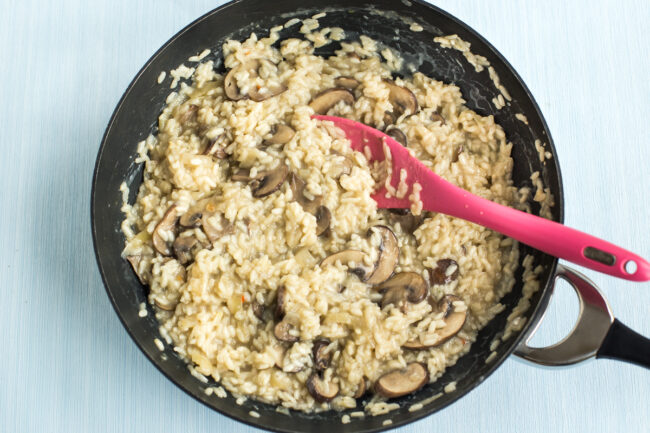
Do you need to stir a risotto constantly?
Not really – but lots of stirring is definitely a good thing. It really isn’t going to matter if you stop stirring for a couple of minutes while you pop to the loo or cut up some veggies, but you ideally do want to keep things moving if you can.
The main reasons to stir a risotto are:
- stirring helps the rice to release its starch, making your risotto super creamy
- it helps your risotto to cook nice and evenly
- it means you can constantly scrape down the sides of the pan, so no grains of rice get left behind
- it keeps the heat evenly dispersed through the risotto, so it won’t spit hot starch at you or burn on the bottom!
Keep stirring and slowly adding stock until the rice cooks to your liking. Some people prefer the rice to stay al dente – personally I like it to be completely soft.
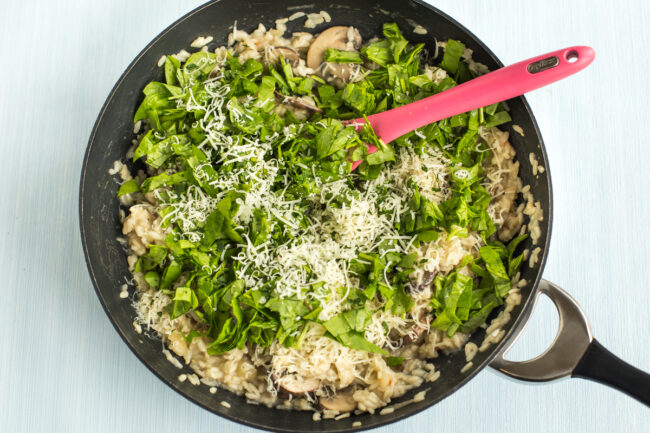
Step 5: Add any tasty extras to your risotto
At this stage, your risotto will be perfectly edible. Give it a taste – it will probably be fine, but perhaps still a bit bland, like it’s missing something.
At this point, you can add all those tasty extra bits that will raise your risotto to the next level.
These should all be things that don’t really need any cooking, just heating through. Some ideas:
- grated cheese
- fresh chopped spinach
- fresh herbs (parsley goes beautifully with mushrooms!)
- halved cherry tomatoes
- a big dollop of pesto
- tomato puree
- coconut milk
Just stir these ingredients through the risotto until it’s all well combined, and serve! Risotto is best eaten straight away. You can make it nice and thick, or leave it saucy, it’s totally up to you.
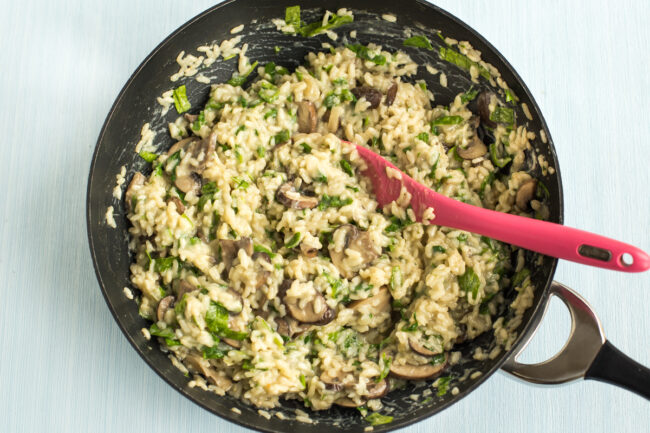
Can I make a vegan risotto?
Absolutely! The only non-vegan ingredient that I usually include in my risotto is a bit of grated cheese, so you can just skip that to make a vegan risotto. If you know of a tasty vegan cheese that melts well, that could work too.
If you are skipping the cheese, make sure you get plenty of flavour in elsewhere – lots of fresh herbs and an extra pinch of salt should be enough!
The cheese does also add even more creaminess to a risotto, but if you’re feeling adventurous, try adding avocado instead – avocado risotto is super creamy!
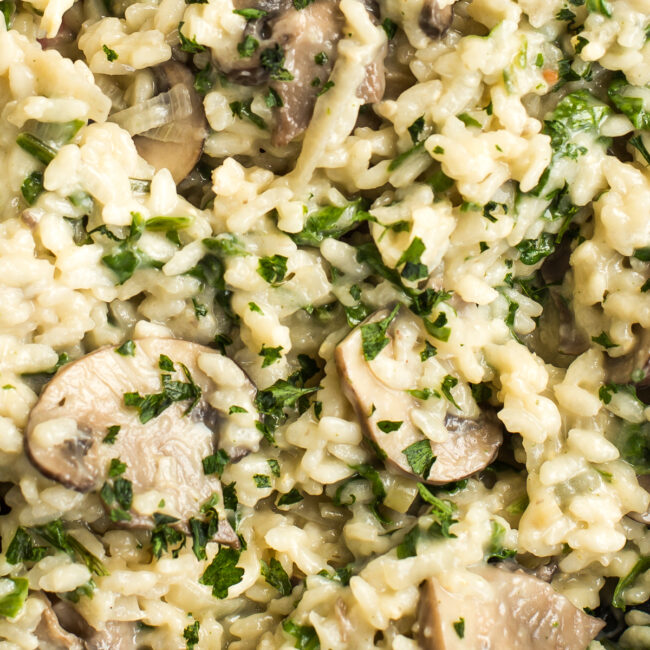
Is parmesan cheese vegetarian?
Just a quick note about parmesan cheese!
I often use parmesan in my risottos, as it’s got a really salty, rich flavour, and melts beautifully. But make sure you use a vegetarian version if you need to, as real parmesan cheese isn’t actually vegetarian – it’s made using rennet, which comes from animals.
The vegetarian version is easy to find – it’s not true parmesan, as the word parmesan is a protected term, but it’s usually just called ‘Italian hard cheese’ or something equally generic. It’s basically the same cheese, but made without the animal rennet – just double check the ingredients to be sure!
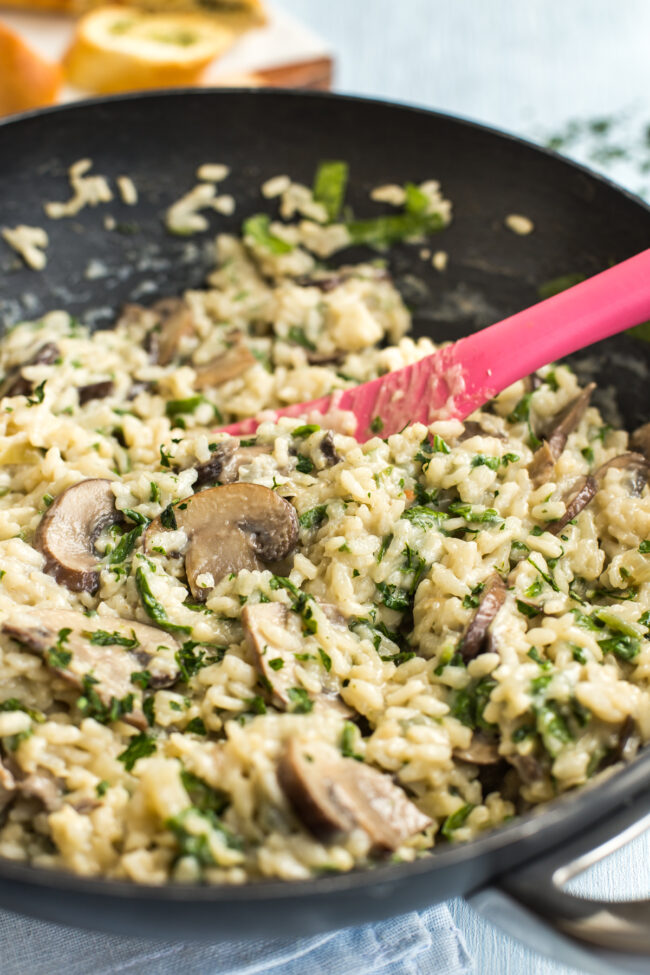
How to serve risotto
In Italy, risotto is often served as a ‘first course’, as a standalone dish that comes before the main course. But assuming you’re just having the one course for your dinner (we can’t all be fancy all the time), risotto would usually form the main part of your meal.
If you like, it can be used as a side dish alongside some kind of protein or other veggie dishes. But personally, I find it’s perfect as the main meal, with just some salad or garlic bread on the side for mopping up the bowl.
You can also use risotto as a filling for stuffed vegetables!
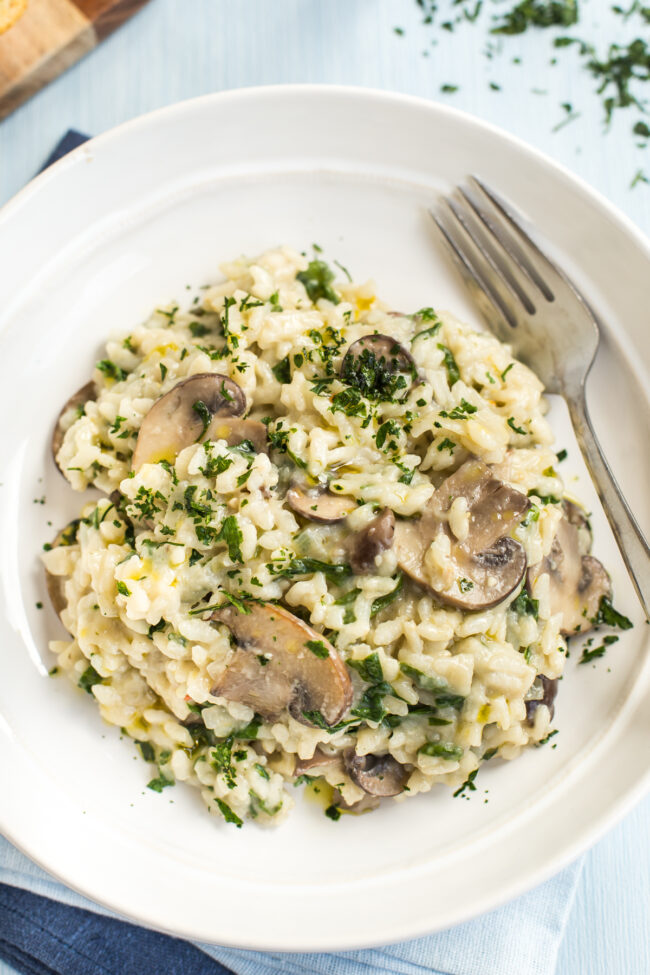
Can you reheat risotto?
Yes! Risotto is best eaten fresh, but it can definitely be reheated without any major issues.
Just be aware that it will be a bit thicker after it’s been reheated, so you might need to add a splash more water or stock first. The best way to reheat risotto is to put it back in a pan on the stovetop, but you can use the microwave instead if you prefer.
There is a small chance of food poisoning when reheating rice, so as is always the case, make sure you follow the official recommendations – for example, cool the rice quickly, store it in the fridge, and reheat thoroughly. All common sense really!
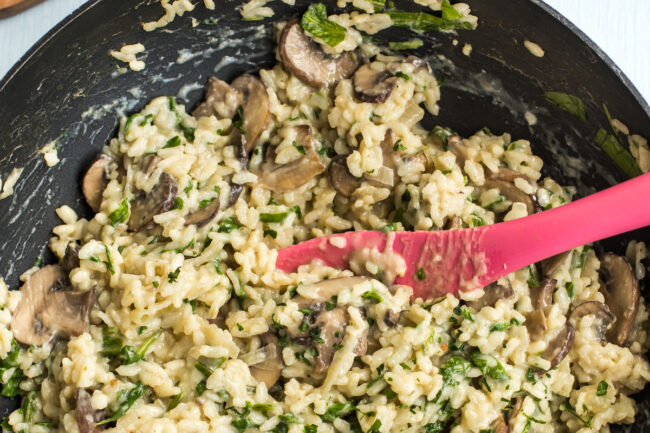
What flavour risotto could I make?
If you’re not a fan of my mushroom risotto, there are plenty of other options! Here are a few ideas, which can all be made using this basic process:
- carrot and coriander (cilantro) risotto
- tomato risotto, using tomato puree or fresh cherry tomatoes and basil
- pea and mint risotto
- a simple cheese and chive risotto
- risotto primavera, with lots of different colourful spring veg
- vegan avocado risotto
- pumpkin risotto, using pumpkin puree – great with sage!
- a vibrant beetroot risotto
…or pretty much any other combination you can think of.
Do you have any top tips for how to cook an easy risotto from scratch? I’d love to hear your thoughts in the comments!
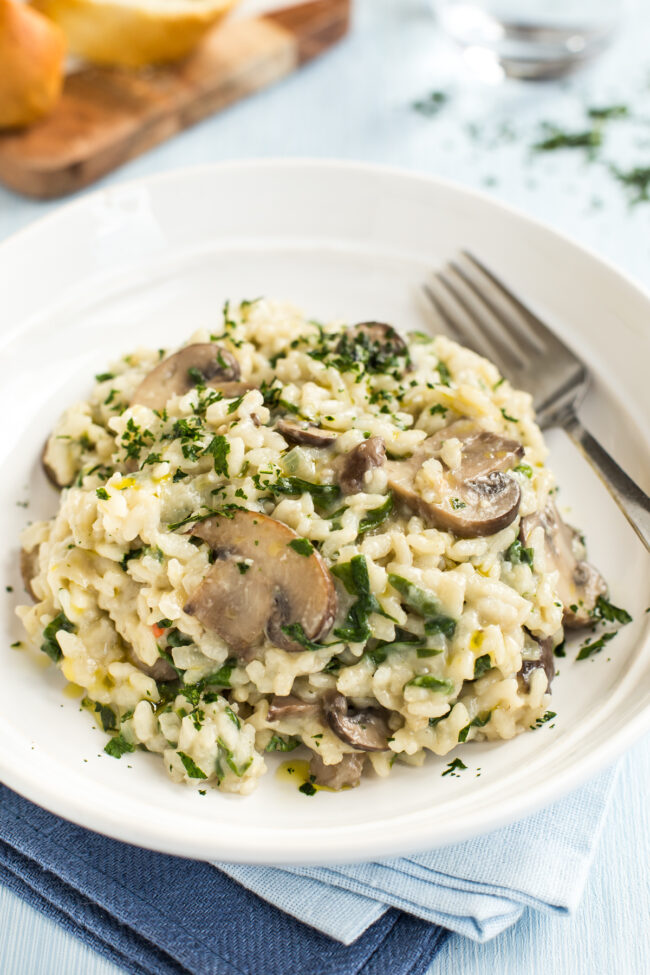
How to make an easy risotto (in any flavour!)
My ultimate guide for how to make an easy risotto from scratch – in any flavour you like! It really isn’t tricky.
Prep Time: 10 mins
Cook Time: 40 mins
Total Time: 50 mins
Servings: 3 people
- 1 tbsp oil
- 1 onion or 3 shallots, sliced or diced
- 2 cloves garlic, minced
- ~ 8 medium mushrooms, sliced or diced (or an alternative vegetable)
- 300 g (~ 1 1/2 cups) arborio rice
- 1 1/4 litres (~ 5 cups) vegetable stock
- 1 large handful fresh spinach, roughly chopped
- Few sprigs fresh parsley, chopped
- 50 g vegetarian parmesan-style cheese, finely grated (~ 1/2 cup when grated)
-
Heat a dash of oil in a large pan or wok, and add the onion. Cook over a medium-low heat for 5 minutes, until soft and translucent, then add the garlic and mushrooms (or whatever vegetable you’re using). Continue to cook for a further 5-10 minutes until the mushrooms have cooked right down.
-
Add the rice, and cook over a medium heat for a minute or two, mixing well to coat it in the oil.
-
Next, add about 250ml (1 cup) of the vegetable stock. Mix well, and allow to simmer gently for a few minutes until most of the excess liquid has been absorbed. Add the remaining stock about a cup at a time, allowing it to be absorbed each time before adding more (you can use a little less or more than the recipe states, if needed). Stir the risotto regularly to help it become nice and creamy.
-
When the rice is cooked to your liking (after around 30 minutes or so), add the chopped spinach, parsley, and grated cheese. Mix well, stirring until the spinach has wilted and the cheese has melted, then serve.
Nutrition Facts
How to make an easy risotto (in any flavour!)
Amount Per Serving (1 portion)
Calories 501
Calories from Fat 80
% Daily Value*
Fat 8.9g14%
Saturated Fat 3.1g16%
Cholesterol 12mg4%
Sodium 176mg7%
Potassium 368mg11%
Carbohydrates 89.7g30%
Fiber 4.5g18%
Sugar 2.5g3%
Protein 14.9g30%
Calcium 140mg14%
Iron 3.6mg20%
* Percent Daily Values are based on a 2000 calorie diet.
Note: Nutritional information is approximate, and will depend on exactly what ingredients you choose. Information above is for 1/3 of the recipe.
Want to perfect another classic recipe? How about macaroni cheese!
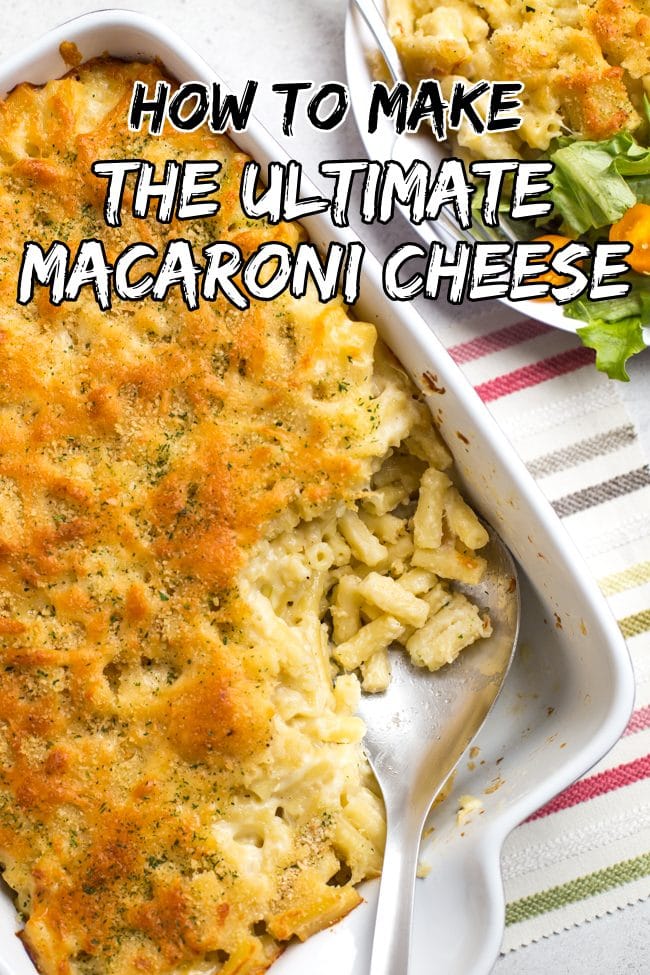
Source link